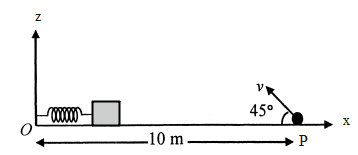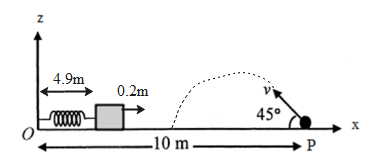
A small block is connected to one end of a massless spring of unstretched length $4.9m$ . The other end of the spring (see the figure) is fixed. The system lies on a horizontal frictionless surface. The block is stretched by 0.2 m and released from rest at t=0. lt then executes simple harmonic motion with angular frequency $\omega =\dfrac{\pi }{3}rad/s$.
Simultaneously $t=0$ , a small pebble is projected with speed v from point P at an angle of $45{}^\circ $ as shown in the figure. Point P is at a horizontal distance of $10m$ from O. If the pebble hits the block at $t=1s$ , the value of v is $\left( g=10m/{{s}^{-2}} \right)$

A. $\sqrt{50}m/s$
B. $\sqrt{51}m/s$
C. $\sqrt{52}m/s$
D.$\sqrt{53}m/s$

Answer
520.2k+ views
Hint:When an external force is applied to a mass that is attached to a spring whose one end is fixed the body undergoes an SHM (simple harmonic motion) motion. And when an object is projected at a certain angle with some speed the object performs a projectile motion. For the interaction of the object performing these kinds of motion, the object (pebble) has to cover a certain distance (range of flight) in the given time interval.
Complete answer:
The unstarched distance of the spring is $4.9m$
Angular frequency of SHM $\dfrac{\pi }{3}rad/s$
The angle of projection of pebble is $45{}^\circ $
Time ($t$) is $1s$
The condition mentioned in the question can be illustrated more with the diagram given billow,

According to the hooke's law, the force required to move a mass attached to a spring whose one end is fixed at a point is given by,
$F=-kx$
Where, $x$ is the distance displaced by the object.
The distance covered by a body performing SHM is given by,
$x=A\cos \omega t$
By putting the values from the given data,
$\begin{align}
& x=0.2\cos \frac{\pi }{3}(1) \\
& x=0.1m \\
\end{align}$
So the new position of the block at a time $t=1s$from the origin (reference point) will be,
\[4.9+0.1=5m\]
Now if the pebble undergoes a projectile position and at$t=1s$ the pebble and block comes in contact. The distance which the pebble have to cover will be,
$10m-5m=5m$
Thus, the range of the projectile is found out to be $5m$.
In the case of projectile motion, the range of flight is given by,
$R=\dfrac{{{v}^{2}}\sin 2\theta }{g}$
By rearranging, the velocity of the pebble is given by,
$v=\sqrt{\dfrac{Rg}{\sin 2\theta }}$
By putting the values, the velocity of the pebble will be,
$\begin{align}
& v=\sqrt{\dfrac{5(10)}{\sin \pi/2 }} \\
& \Rightarrow v=\sqrt{50}m/s \\
\end{align}$
Thus, the correct option which satisfies the question is Option A.
Note:
The distance by which a block is stretched and released to perform an SHM constitutes the initial amplitude of the simple harmonic motion (SHM). If two bodies have to meet at a certain time they have to cover the distance between then in the same interval only. The velocity required by one body to reach a point depends on the distance it has to travel in the given period.
Complete answer:
The unstarched distance of the spring is $4.9m$
Angular frequency of SHM $\dfrac{\pi }{3}rad/s$
The angle of projection of pebble is $45{}^\circ $
Time ($t$) is $1s$
The condition mentioned in the question can be illustrated more with the diagram given billow,

According to the hooke's law, the force required to move a mass attached to a spring whose one end is fixed at a point is given by,
$F=-kx$
Where, $x$ is the distance displaced by the object.
The distance covered by a body performing SHM is given by,
$x=A\cos \omega t$
By putting the values from the given data,
$\begin{align}
& x=0.2\cos \frac{\pi }{3}(1) \\
& x=0.1m \\
\end{align}$
So the new position of the block at a time $t=1s$from the origin (reference point) will be,
\[4.9+0.1=5m\]
Now if the pebble undergoes a projectile position and at$t=1s$ the pebble and block comes in contact. The distance which the pebble have to cover will be,
$10m-5m=5m$
Thus, the range of the projectile is found out to be $5m$.
In the case of projectile motion, the range of flight is given by,
$R=\dfrac{{{v}^{2}}\sin 2\theta }{g}$
By rearranging, the velocity of the pebble is given by,
$v=\sqrt{\dfrac{Rg}{\sin 2\theta }}$
By putting the values, the velocity of the pebble will be,
$\begin{align}
& v=\sqrt{\dfrac{5(10)}{\sin \pi/2 }} \\
& \Rightarrow v=\sqrt{50}m/s \\
\end{align}$
Thus, the correct option which satisfies the question is Option A.
Note:
The distance by which a block is stretched and released to perform an SHM constitutes the initial amplitude of the simple harmonic motion (SHM). If two bodies have to meet at a certain time they have to cover the distance between then in the same interval only. The velocity required by one body to reach a point depends on the distance it has to travel in the given period.
Recently Updated Pages
Master Class 12 Business Studies: Engaging Questions & Answers for Success

Master Class 12 Economics: Engaging Questions & Answers for Success

Master Class 12 English: Engaging Questions & Answers for Success

Master Class 12 Maths: Engaging Questions & Answers for Success

Master Class 12 Social Science: Engaging Questions & Answers for Success

Master Class 12 Chemistry: Engaging Questions & Answers for Success

Trending doubts
What is meant by exothermic and endothermic reactions class 11 chemistry CBSE

Which animal has three hearts class 11 biology CBSE

10 examples of friction in our daily life

One Metric ton is equal to kg A 10000 B 1000 C 100 class 11 physics CBSE

1 Quintal is equal to a 110 kg b 10 kg c 100kg d 1000 class 11 physics CBSE

Difference Between Prokaryotic Cells and Eukaryotic Cells




